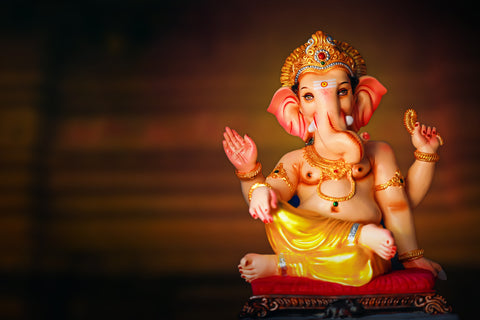
HISTORY
According to Hindu mythology, Lord Ganesha is believed to be the son of Lord Shiva and Goddess Parvati. When Lord Shiva was forbidden by Lord Ganesha to enter the vicinity of Goddess Parvati, Lord Shiva was enraged and cut off Lord Ganesha’s head. On knowing the mere cause of Lord Ganesha's treatment of him by Goddess Parvati, Lord Shiva replaced Lord Ganesha's head with an elephant’s head to make Goddess Parvati stay at peace.
Lord Ganesh is therefore always depicted with an elephant’s head, four arms and muscular torso. Also known by several other names like Lambodara, Ekdanta and Vinayaka, Lord Ganesha is worshipped for blessing humans with fortunes and wiping off any obstacles and bad omens from their path.
SIGNIFICANCE
Ganesh Chaturthi is one of the most significant and glorious Hindu festivals celebrated for Lord Ganesha across India. Ganesh Chaturthi also known as Ganesh Utsav or Vinayaka Chaturthi/Chaviti is an auspicious festival celebrated for nine days in a row. Lord Ganesha, the son of Lord Shiva and Goddess Parvathi Devi, is the god of immense knowledge and new beginnings.
GANESH FESTIVAL MONTH
Vinayaka Chaturthi annually takes place between the months of August and September. During the Bhadrapada MAsam, the Hindu month. For ages, it is believed by the elders and ancestors that the Lord Ganesha was born on this Ganesh Chaturthi day. Lord Ganesh represents wisdom, good fortune, auspiciousness, and prosperity. Lord Vinayak is worshipped by 98% of the population and before starting any new works or the main puja, it's a must to offer prayers to Lord Ganesha as a ritual.
2023 GANESH CHATURTHI DATE and CELEBRATION
This year 2023, the Ganesh Mahotsav festival is celebrated in September, corresponding to the Shukla Paksha of the Bhadrapada Masam according to the Hindu calendar on Thursday, September 19th. The Ganesh Visarjan is done on the 10th day as of September 28th, 2023.
Starting with Ganesha statues are placed on platforms that are decorated on stage at homes or in the streets under outdoor tents. The first step to begin is worshipping the idol through a rite to bring the to life called Pranapratishtha, followed by Shodoshopachara puja. Different flowers are offered to Lord Ganesha while the statue is immersed in kumkum, haldi and red sandalwood paste, the next step is Ganesh Upanishad and Vedic mantras being chanted.
On this special festival day, after the ritual puja is done, prasads(prasadam) are prepared and offered to the idol Ganesha. Coconut, jaggery, modak sweet (21) and kudumulu are considered to be Lord Ganesha's favourite dishes. After the 9 days of worshipping rituals, at the end of the festival, the idol is taken to the visarjan or nimarjan in the rivers along with devotional singing, dancing and drumming events throughout the way. This part of immersing Ganesha’s idol in the river waters represents Ganesha’s return to Mount Kailash, the home of his parents Shiva and Parvati.





